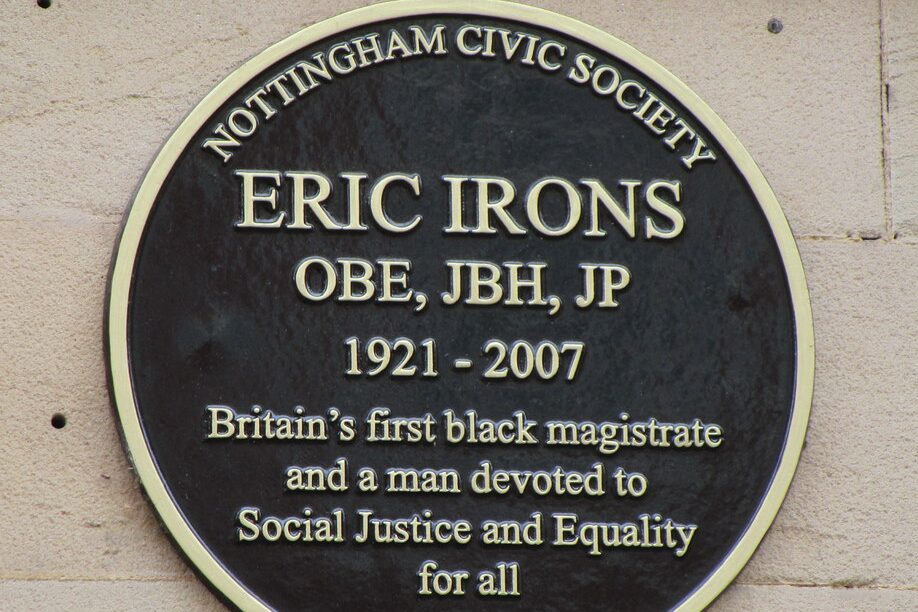Eric Irons OBE is the subject of Honey Williams‘ mural on Carrington Street Bridge, Nottingham.
The mural was designed and painted by Honey, with support from Alex Hobby, City Arts (Nottingham) and Reiss Mallett. It was commissioned on behalf of The Nottingham Project and Canal & River Trust.
Dr Panya Banjoko, founder of Nottingham Black Archive, wrote this article about the life and achievements of Eric Irons.
Eric Irons was born in Spanish Town, Jamaica, in 1921 and served in the Royal Air Force during World War II. After extending his military service he settled in Nottingham marrying and raising a family of six children until his death in 2007. It was in 1962 that he was propelled into the spotlight when he was made Britain’s first Black Justice of the Peace (magistrate). He would serve on the bench in Nottingham, from the early 1960s, for 29 years until he retired in 1991. Throughout his life he was awarded the Jamaican badge of honour, an honorary degree from the University of Nottingham, and an OBE in 1978. In 2019 a memorial was displayed on the facade of the National Justice Museum in honour of him.

Irons was well known as a campaigner for social justice and notably known for helping Nottingham City Council address the problems post the 1958 racial disturbances in St Ann’s. It was February 1960 that the Council appointed him to the specially created post of “Organiser for Educational Work Amongst the Coloured Communities”. The term “coloured” was the language used in the 1960s and 1970s to refer to Black people but is now outdated. Irons was already well known as the leader of the Colonial Club for West Indians and had been serving on the Consultative Committee responsible for the welfare of Black People. He was also a clerk in the City Department of Education.
While many know Irons as the UK’s first Black Justice of the Peace few remember the campaign to abolish the role he held as Special Officer in the 1960s — the “Campaign to Abolish Special Officers for Coloured People”. It was December 6, 1964, when it was decided there was a need for a campaign to abolish the role he had been appointed to deal with members of the African Caribbean community. The campaign would begin to mark a political divide between how some Black people conducted their activist affairs and how Irons worked towards social justice. Documents held by Nottingham Black Archive charts the campaign against the role Irons held for over a period of five months from December 6, 1964 to May 1965. It also highlights the role of the Consultative Committee in creating divisions by using Irons as a buffer between themselves and the Black community and the fissures this then caused within sections of the community.

Some felt that the Committee, founded in 1954, was consciously hindering Black people and preventing them from organising for action against racism. Others were dissatisfied with the Committee being nonrepresentative of the Nottingham community and because of its weak stance on racial discrimination and colour bar.
The campaigners set out a plan to organise a petition and to generate a questionnaire which would establish in more detail the feelings of the Black community towards the post that Irons held. While Irons had a reputation as a leader among the host community, he perhaps was placed out of his depth in the role they gave to him. The campaign against Irons moved in earnest for a short while before community support began to wane. Many agreed with the terms of the petition but felt “it could only be achieved through supernatural force”, perhaps alluding to systemic racism. The campaign to abolish special officers would continue throughout the 1960s without success and members of the Black community would pursue alternative routes to more diverse representation. Eventually the campaign dwindled, and Irons maintained his position.

Irons was later made an honorary life member of the West Indian Students’ Association founded in 1966 and would play an instrumental role in the West Indian Ex-Servicemen’s Association and the African Caribbean Family and Friends Centre, both now dissolved. The mural on Carrington Street Bridge is the most recent tribute to mark the contribution of Eric Irons to the local community in Nottingham and his wider achievement as the country’s first Black magistrate.
